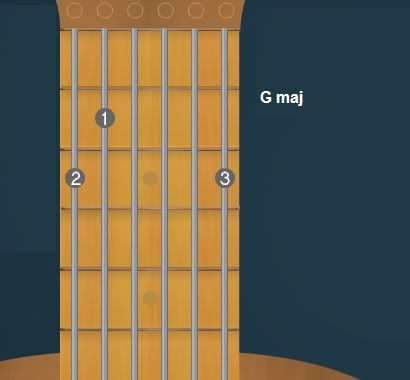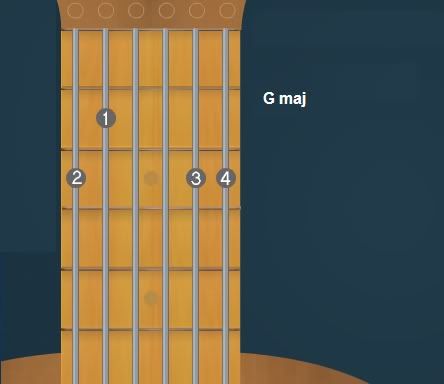I having real trouble landing that G chord..... :cry:
I'm almost getting a rhythm going on my chord progressions, until I come to the G.....
Any body got any tips or links to a video of landing that chord?
"How"??? What kind of G??? Although in time you'll learn to land any chord pretty much anywhere...maybe you should restructure the previous chord. Are you barring the G fret and holding the rest of the chord with your last three fingies???
All in all...this is where practise is what's the cure, matey!
Cat
"Feel what you play...play what you feel!"
Hi Adrian. Some people play the G chord with the middle, ring and pinkey fingers. I use the index, middle and ring most of the time. Depending on what's going on in the song, I'll decide which fingering to use.
Not to make light of your question, but it really is just a matter of practicing. In time it will become second nature to you. I would suggest you start slowly, concentrating on hitting the chord. Tempo can be increased after the basics are taken care of. Good luck, and keep at it.
Denny
Hi Adrian,
I also use both fingerings like Denny. Usually I use middle-ring-pinky when the previous chord is, for example, a C major. It is easier to me. I use the index-middle-ring fingering otherwise.
The Denny's suggestion is very good. Try to reduce the speed. Some time ago I had a lot of troubles with the Dm chord. A lesson in the main site recommends to practice each change to/from the chord you want to practice to the others. I did it with the Dm and now I play it like the other chords. (I think the lesson is written by Greybeard, I'm sorry, I didn't remember the tittle.)
Good luck!
Also note that the angle of your wrist will affect how well you play the chord. Which falls under the "good posture" category.
Keep your elbow away from your body
Don't hold the neck of the guitar like a baseball bat
Turning your wrist slightly away from the guitar will help you to position/place your fingers better.
Also, you could try using fingers 123 or 1234.
Edit: Fixed (Thanks David! WOW- How'd I mess that one up?? That's what happens when you're rushing off to meetings and trying to post answers at same time! :lol: )

Teamwork- A few harmless flakes working together can unleash an avalanche of destruction.
Hi Adrian,
my Gs are bit shaky as well :-) Most of the time I am using the 234 combintation as it makes changing to C easier. During the last 2 weeks I spent lots of time changing to and from G, and the improvements have been pretty good.
What helps me is to find an anchor when changing to G. I often try the pinky on the high E string, and it's starting to work, but more often I move the ring finger to the 2nd fret of the A string, use it as an anchor point and move the other fingers into place. This needs to be done very slowly for a while.
Three other lessons I learned and now apply on a regular basis when playing:
- look at the left hand fingers when changing chords. For me, it reinforces the chords in memory
- visualise the chord before changing to it. This has a huge positive effect
- play with your whole body - by which I mean that you physically move into a chord, and each of them is different.
FOr me, playing it with index, middle and ring fingers was easy to learn.
Middle, ring, and pinky took a lot longer, and goes shaky sometimes. (But in the beginning, it was always shaky)
Learn both. I like to use the index finger when coming out of E chords, starting with middle when coming out of C...
Mostly, just set the metronome slow. In the beginning, it doesn't matter much about the metronome, cause your rythm may not be real regular, but just try. Play C,C,C,C,G,G,G,G,C,C,C,C,G,G,G,G, on simple quarter notes. As slow as you have to. And your fingers get stronger. When they do, then it gets easier, and you can speed up the beat and vary the strum.
Best,
Ande
PS- If you're not used to using your pinky much, start slow, just a couple of minutes a day. Cause it could hurt a little.
Thanks for reminding me of where I came from. I can remember having the same problem. We all can.
Good news, it does get to be so easy you don't even have to think about it and pretty darn quickly at that.
My advice, don't try playing the chord with any speed whatsoever. Go so slowly that all of your fingers hit the strings at the same time in the correct place. I mean painfully slowly. You'd never play this slowly anywhere kind of slowly. Once you get the feeling of that, place your fingers on the neck in a C chord and make that slow switch again. A couple hundred time should do it. You'll have no problems after that. :D
Good luck.
I've been playing about 6 months now, and the G Maj chord was for some reason the very first chord I learned. I play it with the index, middle and ring. Right now, it is one of a handful of chords that I don't even have to look at the fretboard to hit it. I've tried using the middle, ring and pinky way, but it just felt too awkward.
But lately, I've started playing with all four fingers for the G chord, that is, fretting both the B and E string on the 3rd fret with the ring and pinky. It gives a much fuller sound. Since I've been trying it that way, now when I try using a 3 finger G with middle, ring and pinky, its not so awkward, but it still is a little.
The point of my post?
It all boils down to practice. There is no way around it.
I had the same problem with the C chord when first starting, because of the spacing I had to look at the fretboard everytime I went to play it. Now I can hit it most of the time without looking. All because of practice.
Agile AL-3100 Cherry Sunburst Slim Neck (2008)
Dean Vendetta XM (2008)
Line 6 Spider III 15W
Line 6 TonePort UX1
Marshall MS-2 5W
My advice, don't try playing the chord with any speed whatsoever. Go so slowly that all of your fingers hit the strings at the same time in the correct place.
I found that hitting them all at the same time was hard to do at first. Even when slow. I would focus on one finger and make it go to the right place and the others would come along but not at the same time. What I found useful here was to switch which finger I would focus on. So, for the index, middle, ring G chord focus on making the index finger get there first and then the middle finger, and finally the ring finger. If you only work it with, for example, the index finger going there first then you've only figured out how to get the ring and middle fingers to their destination in relation to the index finger.
This really helped when learning the basic chords and I still use it when learning difficult new chord shapes.
Pop music is about stealing pocket money from children. - Ian Anderson
What I found useful here was to switch which finger I would focus on. So, for the index, middle, ring G chord focus on making the index finger get there first and then the middle finger, and finally the ring finger. If you only work it with, for example, the index finger going there first then you've only figured out how to get the ring and middle fingers to their destination in relation to the index finger.
I've been trying this and it seem to be working...I think my old way of doing the G, was to move the hand to get the little finger on the string and then roll in the others. Which did not 'work' any muscles in the little finger. Concentrating on placing the index first has made me have to move the little finger.
( I perhaps should have mention that my guitar is a Nylon Strung Classical - so has high action and wide fretboard. But Inherited it and it was free maybe in couple of months i'll upgrade to an acoustic( Fender CD60 looks good value at the moment) - hopefully all the exercise will have worked....)
The open G is the albatross 'round my neck. Several months of playing, and still can't make that stretch.
My solution is to play it as a barred E on the 3rd fret. Slightly different voicing, but the sound is full. Pretty easy to transition to F (same shape, 1st fret), C (A shape, same fret), or D (C shape, 2nd fret).
If I need a really fast transition to something else, I sometimes go with a simplified open G (3-0-0-0-x-x).
Although it's certainly good to know and be comfortable with both fingerings, my suggestion is to emphasize the 2-3-4 fingering, leaving the index finger free. Once you do that, you can barre the shape up and down the neck, adding a lot to your versatility. In fact, I've made a point of playing even my regular open chords with only the 2-3-4 fingers (I think of it as a barre at fret 0).
A couple of points:
- Do it slowly and correctly
- move all your fingers at the same time. It is temping to move them in a series, but you need to be able to hit the chord all at once. Don't get into bad habits now.
- try different finger combinations, as others here have mentioned. There is no "wrong way" to play the chord at this stage of the game. You will find that eventually you will play it one way for song A and maybe with a different fingering for song B
- PRACTICE. pick two or three chords and just work on jumping from one to the other for 30 - 40 minutes. That is how you get it. Once you have it pretty good, try jumping from different chords. A is the easy one, go from A to G and G to A. Then try A to G to G to A (strumming). Then change it and go from D to G to D to G. Then change it up again and go from D to A to G and back again.
-=- Steve
"If the moon were made of ribs, would you eat it?"


